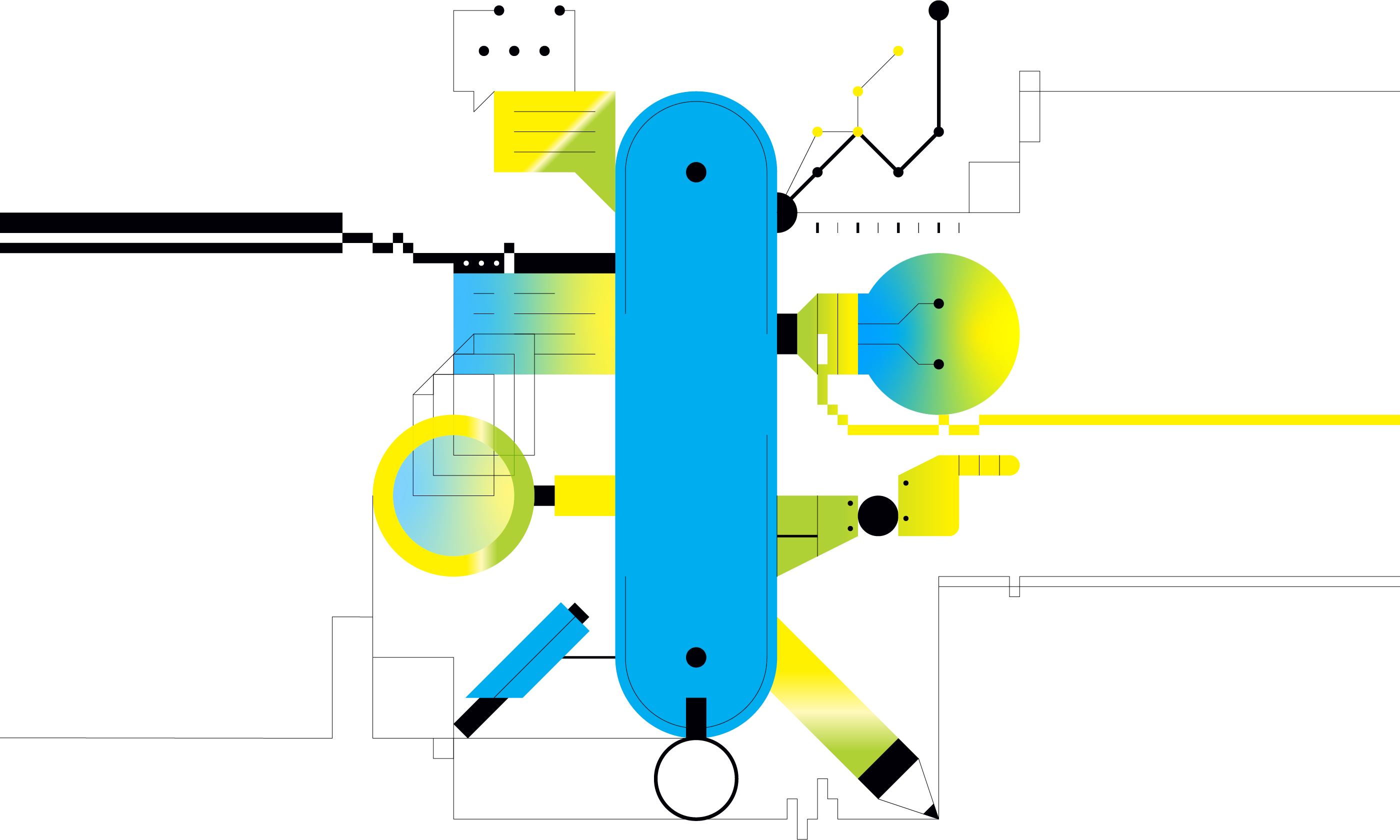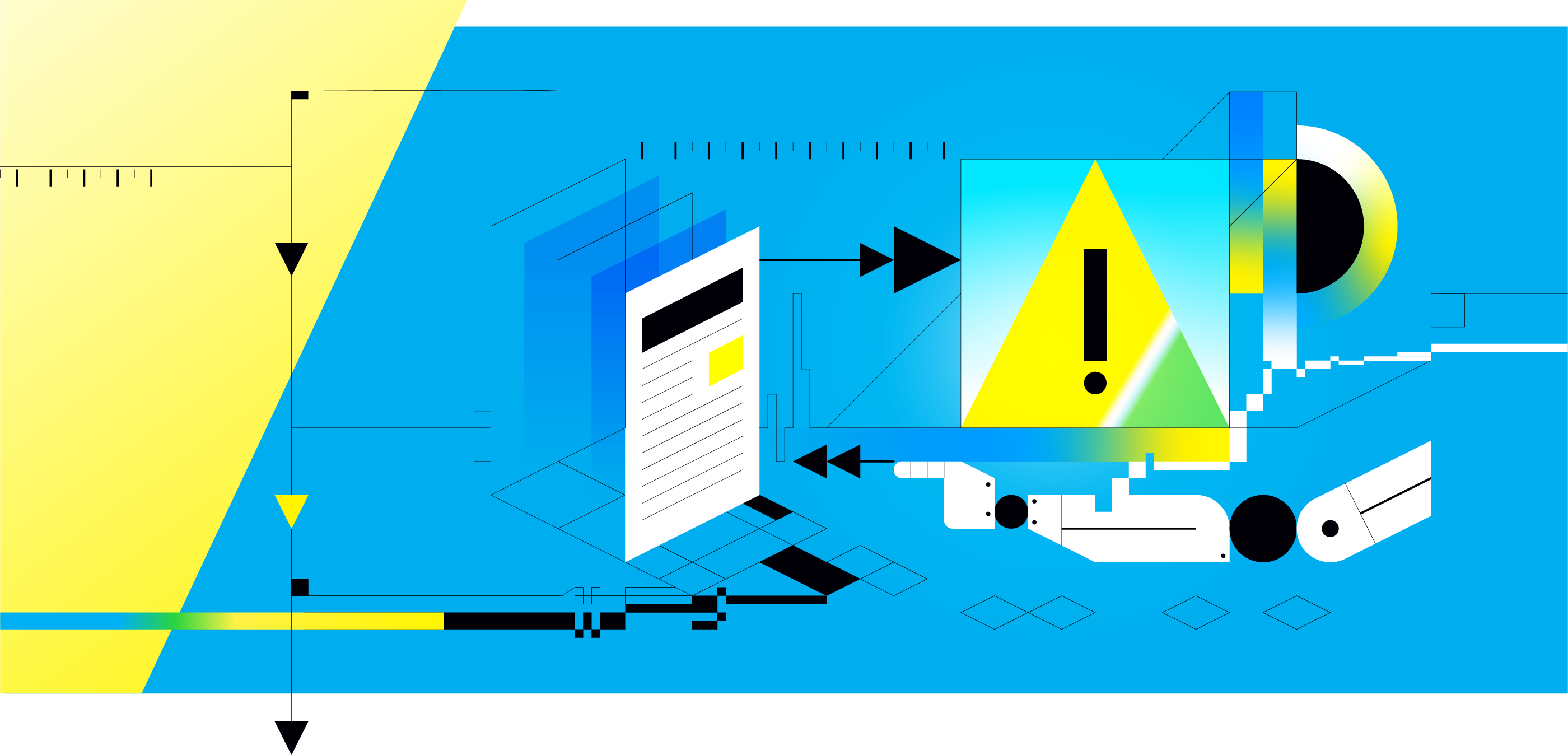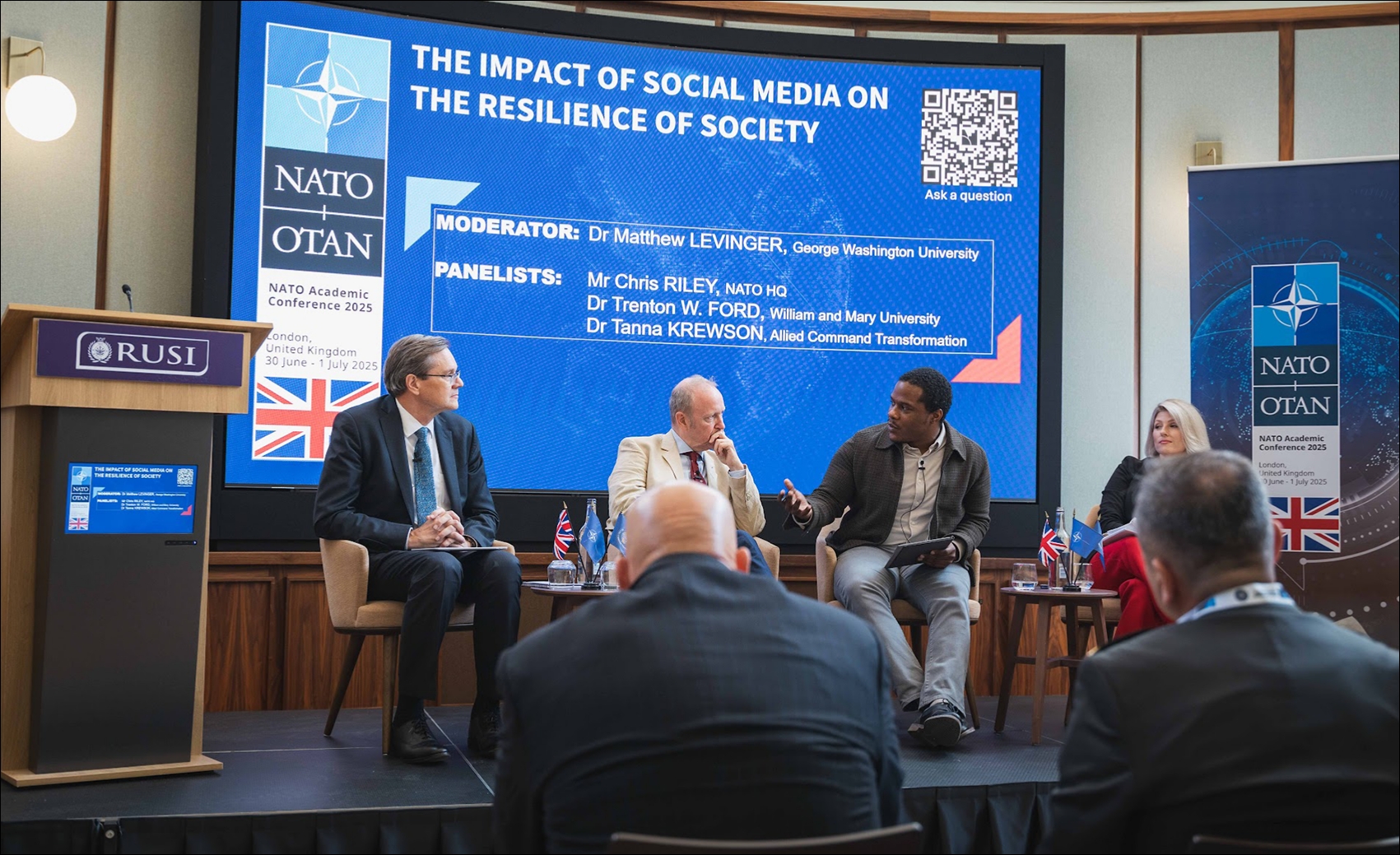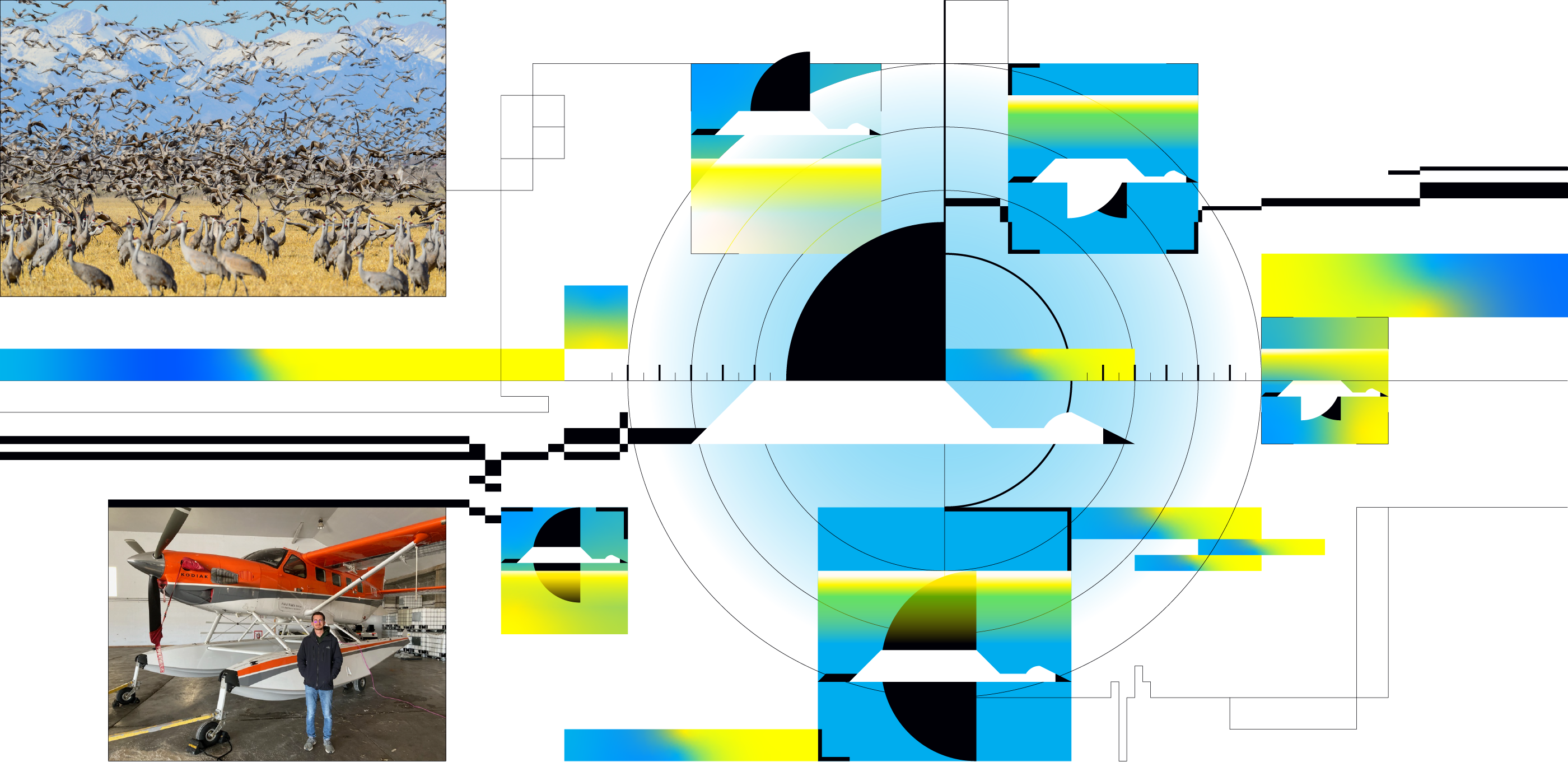‘A Potent Combination’
William & Mary prepares students for an AI-transformed world by blending technical excellence with human insight
October 1, 2025
Story By
Tina Eshleman
Illustrations By
Yann Sadi
William & Mary prepares students for an AI-transformed world by
Artificial intelligence is swiftly reshaping how people worldwide live, learn, work and solve problems. Greater efficiency in business and government, faster service for customers, advancements in medical treatment and accelerated research to solve global challenges are among the most promising developments. But great progress inevitably comes with disruption. The rise of AI is also accompanied by concerns about job losses, data privacy and information warfare.
William & Mary is approaching this time of enormous change as a defining opportunity — one that calls for thoughtful leadership, creative exploration and human-centered innovation. That vision is taking shape through the new School of Computing, Data Sciences & Physics in collaboration with partners across campus and with the alumni community. Officially launched in July, W&M’s first new school in over 50 years represents the university’s next big leap in equipping students, faculty, staff and alumni to lead with fluency and responsibility in a world transformed by emerging technologies.
Here, the dean of the new school and others who are shaping this future share their perspectives.

PROMOTING FLUENCY
“Part of our mission as a school is to help make sure that anybody on campus — whether they’re in our school or arts & sciences or the school of education or the business school — has an opportunity to learn how to master AI tools,” says Doug Schmidt ’84, M.A. ’86, dean of the new School of Computing, Data Sciences & Physics (CDSP).
The need for graduates who know how to use AI effectively is becoming increasingly clear through what Schmidt sees as a “digital chasm” developing between those who have technological knowledge and those who don’t.
“That is going to cause a huge rift in the workforce of tomorrow because the people who have those advanced skills are going to be hundreds, if not thousands, of times more productive than people who don’t,” he says. “I think we’re going to see a huge upheaval in our society. It’s already happening. That’s why it’s so important for places like William & Mary to think strategically about how we are preparing our students to be competitive.”
Because widespread use of AI is so new, he says, “part of our role as a school is to help students become more fluent.” Schmidt expects that to change as incoming students start to arrive with more exposure to AI: “They’re going to be probably fairly facile with AI, but there will be gaps in other areas that they would have learned through a more traditional education process.”
The challenge then becomes how to nurture analytical reasoning, effective communication and other foundational skills.
“William & Mary is well-positioned to do this because we have that wonderful tradition of liberal arts and independent thinking,” Schmidt says. “We’re giving people a world-class education in the foundational liberal arts and sciences and humanities, while also giving them the opportunity to work with cutting-edge tools with AI and automation. It’s that combination that’s our value proposition. As usual, the ampersand makes all the difference.”
A new minor in AI is available through the CDSP this fall,
with a major planned for the next academic year.
Learn More
Schmidt says the school will emphasize internships and research opportunities to prepare students for AI-driven careers and graduate school programs, while incorporating ethical integration of AI in classes and pursuing strategic partnerships with business and industry.
“Business acumen is going to be important,” he says. “We’re working closely with our partners at the business school to give our CDSP students an opportunity to minor in business.”
A business minor combined with technological skills, internship experience and a liberal arts background is a potent combination, he says. “People who have that combination of experience and skills are going to be a lot more competitive. If you really want to future-proof yourself as a college graduate who will hit the ground running and be marketable right out of the chute, it’s going to be this liberal arts foundation, which is about communication, reading and writing, coupled with technology.”
One of the consequences as AI becomes more pervasive is a reluctance to trust written material because of uncertainty about who wrote it, he says. “Employers increasingly are going to be looking at how people perform, how they present themselves.” To maintain competitiveness, Schmidt envisions continued engagement with W&M graduates as they progress in their careers, through specialized courses and webinars.
As part of W&M’s commitment to be a career partner for life, Schmidt says, “We should be helping to inform and enrich and empower our alumni by giving them access to AI tools that will make them more effective.”
PULLING BACK THE CURTAIN
“AI is like a magic trick happening all around us. It writes, paints, sings, even drives cars. Zillow estimates real estate values using neural networks,” says Tingting (Rachel) Chung, who teaches in the MBA and Master of Science in Business Analytics (MSBA) programs at William & Mary’s Raymond A. Mason School of Business. “Buzzwords like deep learning and hyperparameters are everywhere, and yet most people feel like they are watching a magic show they do not understand.”
Chung, whose courses include machine learning and advanced modeling techniques, was addressing an audience at the Sadler Center during the “TEDx William & Mary 2025: Accelerating Innovation” event in March. It’s part of a mission she has taken on to help the community beyond the business school better understand AI.
When she started teaching an AI course at the business school in the spring of 2022, she says, very few students expected artificial intelligence to be a focus of their careers. “When ChatGPT came out in November 2022, the world turned 360 degrees,” Chung says. “Now everybody talks about AI.”
Since then, she has facilitated programs for W&M faculty and staff, and has added a weekend elective course for students. The business school is encouraging faculty to incorporate AI into accounting, finance and marketing and other specialty areas. This past summer, Chung conducted a seminar at William & Mary’s Entrepreneurship Hub called “How AI Works” for about two dozen students, faculty, staff, alumni and Williamsburg-area residents. She also co-wrote an activity book, “AI the Magic Box” — with Alisa Yang ’25, Danielle Seay ’25 and Rani Banjarian M.S. ’20 — to foster technological literacy among middle school-age students.
Using artificial intelligence is a bit like driving a car, Chung says: “You don’t have to be a mechanic to drive a car, but you need to know enough about how it works to know if it’s operating correctly.”
In her TEDx talk, she uses illustrations from her book to show how the “Magic Box” receives input, converts words or phrases — known as “tokens” — to numbers, assigns them weights and multiplies data values to predict an outcome. ChatGPT, for example, mimics interactions based on 500 billion tokens it accessed through the internet.
“The guess can be right, but usually Magic Box guesses wrong,” she says. “Like a child learning to ride a bike, Magic Box fails, wobbles and tries again by adjusting weights and refining guesses over and over again until he gets closer to the correct answer.” At the end of her talk, Chung says, “We have pulled back the curtain and revealed AI as an adorable Magic Box that’s really good at guessing, where its real magic is math.”
However, the true power of AI lies in how we choose to use it, she says. “The real question is, are we going to let AI remain a magic trick or are we going to learn how AI works and use it to accelerate innovation, cure cancer and bring us world peace? The choice is ours.”

SECURITY AND PRIVACY
“Our information landscape is changing in ways that present new problems and new gaps in our ability to predict what’s coming,” says Trenton W. Ford, an assistant professor of data science at William & Mary and director of the Ford AI and Society Lab. China, for example, used to have clearly defined paths in which to communicate with American citizens, he says. Through social media, “those paths are blown wide open in terms of the ability to engage and interfere and influence.”
Ford, who teaches courses on machine learning and generative AI, was a featured expert in the recent NATO academic conference on societal resilience in the digital age. Held in London from June 30-July 1, the conference considered how democratic societies can confront threats from disinformation and cognitive warfare in the form of AI-generated content and deepfakes.
Ford spoke about how technological tools such as those being created in his lab can be used to combat information warfare. He is the principal investigator on two projects with the Defense Advanced Research Projects Agency (DARPA), the central research and development arm of the U.S. Department of Defense. The projects simulate human behavior using digital “twins” based on the demographics of a community and leverage generative AI to create a modeling and simulation framework. The idea is to predict how people in a given community might respond to an event such as a disinformation campaign by an adversary and develop ways to defend against that.
The more sophisticated large language models like ChatGPT become, the more difficult it is to detect whether a message is coming from a chatbot, Ford says. For example, “it is entirely possible that in some of the most fervent arguments being had on social media, one of the parties is not human and the other party does not know.”
Experts at the conference considered how democratic societies can maintain trust in their institutions in such an environment.
“The large takeaway from the conference was, if you can’t quiet the messaging that you think is giving a distorted view of reality, you have to tell your story more convincingly,” he says. Appealing to the shared values of a country’s population can help guard against information warfare: “People will get better at digital literacy if they see it as patriotic to not be easily persuaded by enemies.”

William & Mary plays a role in strengthening democracy by equipping students to be leaders who understand how government systems are supposed to work, Ford says: “It’s hard to be misled if you’re at the front.”
Another faculty member advancing global conversations about AI is Margaret Hu, the Davison M. Douglas Professor of Law, founding director of the Digital Democracy Lab at W&M Law School and Global Research Institute (GRI) faculty affiliate.
Hu is a governance section editor for the online publication “AI in Society” published by Oxford University Press, among her other writing and media projects. She is also the author of a new textbook, “AI Law and Policy,” released by Aspen Publishing in July. Hu says the book, which covers challenges presented by AI and other emerging technologies through a series of case studies, had been in the works for more than five years, but the timetable for publication was fast-tracked after the launch of ChatGPT.
“It used to be that AI in law schools was a sleepy subject,” she says. “Now every law school wants to offer it as a class.”
At William & Mary, the textbook will be featured this fall as part of the Global Scholars Program seminar on the topic of global policy, taught by GRI faculty members Ryan Musto, director of forums and research initiatives, and Kelly Houck ’12, senior program manager of student initiatives.
A former White House policy advisor who has served as special policy counsel with the U.S. Department of Justice, Hu is regularly called upon as an expert witness by congressional leaders. She appeared most recently at a June hearing, titled “Securing American’s Genetic Information: Privacy and National Security Concerns Surrounding 23andMe’s Bankruptcy Sale.”
The genetic testing company 23andMe, which holds personal data from millions of Americans, filed for Chapter 11 bankruptcy protection in March. The hearing opened with House Oversight Committee Chairman James Comer expressing concerns about whether the genetic database could fall into the hands of a foreign adversary.
As Hu explained in written testimony, the subject of the hearing was particularly urgent because “the topic of genetic data privacy, unfolding within the context of the bankruptcy proceedings of 23andMe, is simultaneously unfolding within the context of a larger crisis: inadequate federal data privacy and cybersecurity safeguards generally, and inadequate federal laws to address the challenges of the AI revolution.”
AI & CONSERVATION
“There is real potential with AI in terms of allowing us to see things from a zoomed-out perspective,” says Emilio Luz-Ricca ’23, a Monroe Scholar and one of the first students at William & Mary to major in data science. Now a doctoral candidate at the University of Cambridge in England, he is combining zoology with computer science to explore how artificial intelligence can be used to advance conservation efforts.
It’s a path he discovered as an undergraduate when he came across an application to work on a project to monitor populations of sandhill cranes in central Nebraska by using AI to analyze thermal imagery. Part of the Institute for Integrative Conservation’s Conservation Research Program, the project involved William & Mary’s Center for Geospatial Analysis, the U.S. Fish & Wildlife Service and the U.S. Geological Survey.
Although he had not taken a biology class since ninth grade, Luz-Ricca was drawn to the idea of applying technology to an environmental challenge. The Fish & Wildlife Service (FWS) was looking for a more efficient way to count sandhill cranes, which are being monitored because overhunting has diminished the birds’ numbers in the past.
Having a person manually count the cranes would be time-intensive and not cost-effective, Luz-Ricca says. It’s also difficult to count the birds during the day because they’re dispersed over a wide area. They roost at night, when they’re harder to see, and there could be up to 4,000 or 5,000 cranes clustered together. That’s where thermal imaging comes in, since the birds’ heads give off heat.
“It was an interesting methodological problem, too, because it we couldn’t just take a machine-learning model off the shelf and apply it,” he says.
As a rising junior, Luz-Ricca worked with the conservation partners to develop and train an AI counting model, test which altitudes work best for the planes, collect the thermal images and figure out how to adjust for false positives — so the model doesn’t mistakenly count rocks as birds, for example. He then became the lead author of an article about his research in the journal Remote Sensing in Ecology and Conservation.
Now in graduate school, he is researching the global effects of hunting in pushing mammals toward extinction.
“Artificial intelligence tools help us take raw field studies that only look at one population in one place and bring these together into a large aggregate data set,” he says. “If we bring enough of them together, we can start to make generalizations based on global patterns.”

TRANSFORMING THE WORKPLACE
“I believe there will be more job creation than destruction associated with AI,” says Greg Wallig ’94, chief strategy officer and an investor in THEIA Analytics Group. He cites estimates from the World Economic Forum that 170 million jobs will be created between 2025 and 2030, while 92 million jobs will be displaced. “That’s disruptive and stressful, but the corollary is that there is more job potential. It’s a matter of putting yourself into those new positions.”
Wallig and Elaine Turville ’96, managing director, strategy and consulting at Accenture Federal Services, spoke about “Building Purposeful Careers & Adapting to the AI Revolution” during this year’s W&M Professional Development Week. His company assists stakeholders such as Wall Street investors and analysts, corporate advisors and public company executives in mitigating regulatory and policy risks. He says, “Not only is the product we created and are commercializing an AI product, but we also chose to create the company with an AI-first mentality.”
When working with AI tools, he often gives the same prompt to different platforms to see which comes up with the best result. For example, he told Gemini, Copilot and ChatGPT, “‘I want to do a voiceover with certain criteria. Go to our website and create a storyboard for me.’ All three came up with different versions.”
He uses AI in his personal life, too, as the father of children ages 9 and 13. “Just last night we were researching jet skis — should we get them and which one should we get, and all the criteria that we wanted as part of those considerations,” he says. “We were using AI to game out these different scenarios and help us with decision making and total cost of ownership. It was actually a very useful way to utilize that technology.”
Wallig visits William & Mary’s campus regularly as a member of the academic advisory board for the MSBA program, and he participated in the business school’s “AI in Business Education Summit” in April. At the summit, faculty members described how they’re using AI in their classrooms. In one memorable example, David Long, the J. Edward Zollinger Associate Professor of Business, had trained an AI model to impersonate the CEO of Boeing as part of a case study.
“Students could interact with that persona and ask questions like, ‘Why did you make this decision?’” Wallig says. “And I thought, ‘That’s such a great extension of the classroom that doesn’t detract from the professor’s authority or ability to teach or communicate their message. Students can do this on their own and then engage in a different level of dialogue in class.’”
In addition to a net job gain, Wallig sees an opportunity for people to do more interesting and fulfilling work as a result of AI.
“We are entering an era of more entrepreneurship and less 9-to-5 hierarchical work in the same place for a long period of time,” he says. “So if you’re entrepreneurial and flexible and creative, and you’re a William & Mary T-shaped person — with broad understanding and deep expertise in certain areas — I think you’re going to be great.”
Turville agrees: “You have to focus on functions and topics where you are becoming the expert and they are not things that can be done by AI — conceptually based, thoughtful work.” In the Professional Development Week talk, she advised listeners to keep up to speed by taking AI courses, listening to podcasts and learning how to leverage new technology.
At Accenture, her team uses generative AI tools to gather and sort through volumes of federal government data to research statutory requirements or to find out, for example, what policies a specific benefits program may have paid out in a given year and how those dollars compared to previous years.
“Organizations have massive documents explaining policies and procedures to obtain a benefit or complete an action like applying for a patent,” Turville says. “We load all of these public documents into AI tools, reinventing the process, cutting out wasteful or non-value-added steps.”
Like Wallig, she is optimistic about the potential for AI tools to reduce mundane tasks. She also believes that with greater efficiency, government agencies will be able to process requests for loans or benefits more quickly.
“Sometimes you hear about people applying for programs, and then it takes months to get approved,” she says. “But what if you were able to apply and the person who has to make that decision was able to access all the necessary information in about two minutes, and then could make that decision right away? Those are the things that get me super excited.”
A HUB FOR EXPLORATION
“Every single job in the next five years is going to require some understanding of AI,” says Tucker Peters ’28.
He’s already ahead of the game. Before arriving on campus for his first semester in 2024, he developed an AI-powered stock trading application and created GenEdu.co, a website designed to help students succeed through personalized AI tutoring and research assistance.
Now in his sophomore year, he has launched the W&M AI Club to foster interdisciplinary exploration of artificial intelligence. He consulted with Schmidt, the CDSP dean, for advice on starting the club, which had attracted over 100 members as of Sept. 7.
“My goal originally was to help students with the knowledge I’ve gained,” Peters says. He also hopes to “switch the narrative” about AI so that those who might have a negative view the technology are able to understand its potential.
The club will host “cheat-a-thons” to show the ways AI can be used to complete assignments, helping faculty members create AI-resistant projects and exams. Peters is also planning an AI Week to educate the community about the capabilities of artificial intelligence and the importance of using it ethically and responsibly. (Read more in the online exclusive “Bridging the Digital Divide.”)
Schmidt says the club will help students gain proficiency in using AI for all kinds of projects, adding, “I’m very optimistic that the AI Club will help change the future of William & Mary faster than deans or administrators conveying high-level visions, due to their grassroots approach and close connection with the student culture.”
The W&M AI Club exemplifies the university’s human-centered approach to AI that integrates responsible innovation, ethical considerations and critical engagement. In keeping with the character of the university, William & Mary is channeling interdisciplinary strengths with a sense of determination and a spirit of curiosity to meet the challenges and opportunities associated with this time of technological transformation.